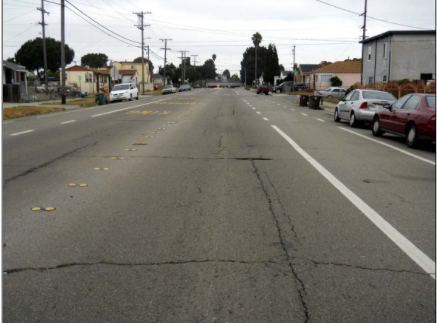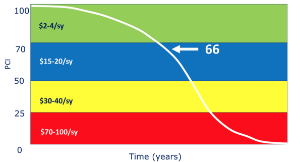Originally published on California Alliance for Jobs.
Yesterday, we reported on the California Statewide Local Streets and Roads Needs Assessment, a biennial report that documents the condition of the 143,000 center-lane miles of streets operated by cities and counties.
 The report’s top-line number is that average road pavement across the state’s 58 counties is rated as a 66, what’s called “at-risk” condition. That’s down from 68 when the study was first conducted six years ago and is 4 points below the 70 that marks the bottom of the “good” category. (In contrast, anything lower than 50 is considered poor/failed.)
The report’s top-line number is that average road pavement across the state’s 58 counties is rated as a 66, what’s called “at-risk” condition. That’s down from 68 when the study was first conducted six years ago and is 4 points below the 70 that marks the bottom of the “good” category. (In contrast, anything lower than 50 is considered poor/failed.)
Why a 66 isn’t good news
At first glance, 66 doesn’t seem to be much worse than 68, and for that matter just barely below good condition. But as they say about relationships on Facebook, it’s a bit more complicated than that. As the report explains:
As was discussed in the 2010 study, an average pavement condition of 66 is not especially good news. While it seems just a few points shy of the “good/excellent” category, it has significant implications for the future. Figure 2.5 illustrates the rapid pavement deterioration at this point in the pavement life cycle; if repairs are delayed by just a few years, the costs of the proper treatment may increase significantly, as much as ten times. The financial advantages of maintaining pavements in good condition are many, including saving the taxpayers’ dollars with less disruption to the traveling public, as well as environmental benefits.
Maintenance is cheap; reconstruction is expensive
 As Figure 2.5 (at left) illustrates, pavement conditions gradually worsen for a certain amount of time, then fall off sharply. That means it doesn’t take many more years for so-so roads to fall into poor condition. And by the time pavement condition falls into the red zone, it’s too late to resurface an existing road; you have to tear it up and reconstruct it.
As Figure 2.5 (at left) illustrates, pavement conditions gradually worsen for a certain amount of time, then fall off sharply. That means it doesn’t take many more years for so-so roads to fall into poor condition. And by the time pavement condition falls into the red zone, it’s too late to resurface an existing road; you have to tear it up and reconstruct it.
The cost differential is enormous. For major roads in the green zone, it costs about $4.85 per square yard to perform preventive maintenance. In the blue “at risk” zone, fixing the same square yard costs $18.82 for a thin asphalt overlay. When you get into the yellow “poor” category, fixing that square yard costs $29.73 for a thicker overlay, and when you’re into the red zone and have to reconstruct, the cost skyrockets to $68.48 per square yard.
While some jurisdictions have been making progress, the overall trend is clearly downward. In 2008, 16 counties (including the cities within them) reported their average road was in good condition and just five said their average road was in poor condition. By 2014, only four counties reported an average in the good zone while the average in nine fell into the poor category. (You can download the entire report here.)
Orange County rated highest; Amador County lowest
Worse, three of the four counties in the good range are just inside it. Orange County fares the best at 77, followed by San Joaquin, San Bernardino and Nevada in the low 70s. Amador County fared the worst at 33, followed by Mendocino at 35, then Lake, Alpine and Mariposa in the low 40s. However, Calaveras, Monterey and Sonoma counties were all just a couple of points above the poor range.
Some 25 cities also reported their roads were in poor condition. The largest was Vallejo, but even the upscale communities of Orinda, Larkspur and Rolling Hills were in the same condition.
——————
Originally published on California Alliance for Jobs.

